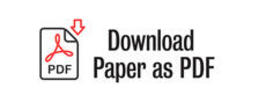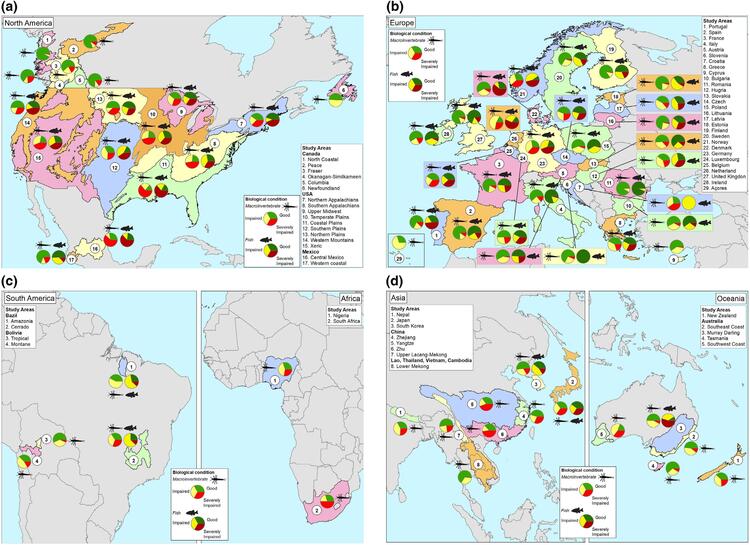Contact
 Adam Yates, Department of Biology
Adam Yates, Department of Biology
Introduction
Rivers across the world are being impacted by multiple, simultaneous anthropogenic pressures that result in excess of nutrients, contaminants, altered flow regimes and connectivity, impaired riparian vegetation and physical habitat structure and spread of invasive non-native species. These stressors have degraded biological assemblage structure and composition, reduced functional diversity and altered ecosystem functioning leading to losses in ecosystem services. Bioassessments are a critical instrument for evaluating the status and trends in riverine health, however, few nations have statutory bioassessment programs limiting rigorous global assessments of riverine biological conditions.
The study analyzed the biological condition of the world's rivers based on existing macroinvertebrate and fish bioassessment data and included the largest Global South dataset assessed to-date. Correlations among anthropogenic pressures and the riverine biological quality were determined and measures to protect rivers that would improve their biological condition were identified. It is hoped that improved understanding of the relationship between the biological condition of global rivers and anthropogenic pressures will support prioritization of river conservation efforts.

Photo: River in Grasslands National Park by Adam Yates.
Methodology
The study gathered macroinvertebrate- and fish-based assessments from 72,275 and 37,676 sites, respectively, from 64 study regions across six continents and 45 nations. To homogenize site assessments and reduce the importance of differences in study designs and sampling and assessment methods, the study converted all the site quality classification systems into a simple three-class system:
- Good (no rehabilitation measures needed; assemblages similar to reference conditions);
- Impaired (scores clearly lower than in reference conditions);
- Severely Impaired (many fewer taxa than expected; substantial alteration in assemblage composition compared to reference conditions).
To assess the impact of anthropogenic pressures, the study correlated site biological quality against several global indices for each region:
- Köppen-Geiger main climate type;
- Human Footprint Index to address landscape alterations;
- Human Development Index to address social welfare;
- UN SDG 6 Clean Water and Sanitation indicators:
- Percentage of rivers with good ambient water quality;
- Percentage of protected freshwater key biodiversity areas;
- Percentage of forest area net change rate.
The study used permutational multivariate analysis of variance (PERMANOVA) to determine if there were significant relationships in the biological classifications among sites with different climate types. Lin's concordance correlation coefficient and Pearson's product–moment correlation coefficient were used to test the correlation and agreement between fish and macroinvertebrate classifications. Pearson correlation was also used to test for significant correlations between the values of the global indices and macroinvertebrate and fish classifications, independently.
Outcomes
Based on benthic macroinvertebrates data, 50 per cent of the sites were in Good condition, 29 per cent were Impaired and 21 per cent were Severely Impaired. Assessments based on fish showed slightly greater degradation with 42 per cent in Good condition, 29 per cent Impaired and 29 per cent Severely Impaired. For study regions with both benthic macroinvertebrate and fish data, site-quality classifications based on fish were consistently lower. Because both fish and macroinvertebrates are affected by changes in water quality and forest area, this difference may be driven by the hydromorphological alterations of rivers. As fish move across larger spatial scales and across habitats within rivers than invertebrates they are more severely affected the fragmentation of rivers and streams by dams, reservoirs, and poorly constructed road-stream crossings. Figures 1 and 2 show site classifications by study regions and areas.

Figure 1: Per cent of sites in Good (green), Impaired (yellow), and Severely Impaired (red) condition based on benthic macroinvertebrate and fish assemblages by large regions. Map lines delineate study areas and do not necessarily depict accepted national boundaries.

Figure 2: Location of the study regions by continent with the per cent of sites in Good (green), Impaired (yellow), and Severely Impaired (red) condition by study region based on benthic macroinvertebrates and fish. Map lines delineate study areas and do not necessarily depict accepted national boundaries.
The study found significant differences among major climate types and the biological condition of rivers with the highest percentages of sites in Good, Impaired and Severely Impaired sites in Snow, Equatorial and Arid regions respectively. Higher protection of rivers in Snow regions and greater societal demands for surface and groundwater in Arid regions, in combination with other pressures, may contribute to these findings.
Results of Human Footprint Index correlations did not support the study’s hypothesis that countries with a longer history of human settlements and modifications (disregarding the impact of First-Nations) would have a greater proportion of sites in poorer condition. However, the study did observe that most regions with a high Human Development Index in the last two decades had a lower percentage of impaired sites than other regions of the world. Biological quality classifications were significantly correlated with UN SDG 6 Clean Water and Sanitation indicators with sites classified in Good condition positively correlated to good ambient water quality, protected freshwater key biodiversity areas and forest area net change rate percentages.
Conclusions
This large-scale analysis showed that more than half of the global rivers studied had Impaired or Severely Impaired biological quality thus negatively impacting the provision of valuable ecosystem services. Correlations between the biological condition of rivers and indicators of anthropogenic alterations showed that measures aimed at improving terrestrial and aquatic ecosystems can be effective in improving their biological condition. Specifically, the study identified a need to increase the extent and number of protected river catchments, preserve and restore natural forested areas in the catchments, treat wastewater discharges and improve river connectivity. It is also important to implement statutory bioassessment programs in Asian, African and South American countries and continue them in Oceania, Europe and North America.
Despite the large number of sites included in this study, results are biased by insufficient information from large continents (Africa, Asia, South America) and large countries limiting global conclusions.
João Feio, M. et. al. Fish and macroinvertebrate assemblages reveal extensive degradation of the world's rivers. Global Change Biology, September 2022. https://doi.org/10.1111/gcb.16439
For more information about WaterResearch, contact Julie Grant.
Photo credit: Adam Yates






